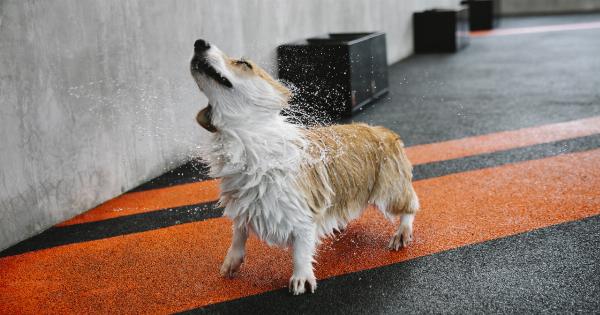Deafness in dogs is a common disability, and it can occur at any time in a dog’s life. Many owners may feel challenged to communicate with a deaf dog, but it is still possible to establish efficient methods of communication.
Here are some practical ways to communicate with your deaf dog and keep them safe:.
1. Use Hand Signals
Dogs are visual creatures, and deaf dogs rely heavily on their sense of sight. Teach your dog hand signals for basic commands like sit, stay, come, and down. Use consistent hand signals, and reward your dog with treats for following your cues.
2. Touch Your Dog
Deaf dogs are very sensitive to touch. Use gentle touches to get their attention and guide them to where you want them to be. Use different types of touches such as pats, nudges, or taps to signal commands.
3. Use Treats and Positive Reinforcement
Treats can be a powerful motivator for deaf dogs. Use treats to reward your dog for following commands or doing desirable behaviors. Use positive reinforcement, such as praise and rewarding, instead of punishment.
4. Use a Vibrating Collar
A vibrating collar can help a deaf dog feel the vibrations of commands a lot easier. The collar will vibrate when a signal is sent to it, and dogs can quickly associate the vibration with a particular command.
Make sure not to overuse the vibrating collar and allow your dog to get accustomed to it first.
5. Make Eye Contact
Eye contact is crucial when communicating with a deaf dog. Always ensure you have your dog’s attention before starting a training session or giving commands. Use visual cues and gestures to draw their attention to you.
6. Use Flashlights
Flashlights can be used as visual signals for recall commands. Signal with the flashlight by flashing it on and off to catch your dog’s attention. Once you have your dog’s attention, use hand signals or hand gestures to reinforce the command.
7. Use Pheromones
Pheromones are a great way to calm your dog and reduce anxiety. Pheromones come in sprays or diffusers, and they can send a calming signal to the dog, effectively reducing the dog’s anxiety and stress levels.
8. Establish a Consistent Routine
Deaf dogs rely on predictable routines, so create a consistent routine that your dog can trust and follow. Use the same words, behaviors, and timing to communicate on a regular basis.
Make sure to keep things consistent in terms of feeding times, potty breaks, and walks.
9. Use Visual Cues
Use visual cues to communicate with your deaf dog, such as pointing to their bed when it’s time to sleep or pointing to the food bowl when it’s time to eat.
You can also use visual clues such as moving your body in a particular way to signal commands.
10. Use Other Sense-Based Cues
Deaf dogs are also highly responsive to smell and touch. You can use scents to create positive associations, such as a scent on your hand that will associate with your dog to correctly follow commands.
Hugging, snuggling, and massage techniques can also serve as a positive bonding experience for your dog.
11. Use Body Language
Your body language is essential when communicating with your dog. Use gestures, postures, and movements like bowing down or raising your arms to signal your dog to come or stay.
Avoid using menacing postures or aggressive body language that could alarm your dog.
12. Use a Flashing Doorbell
A flashing doorbell can be helpful when teaching your dog to respond to the sound of a bell. The flashing light will catch their attention, and they’ll associate it with a command you’re signaling to them.
Just like the vibrating collar, make sure it’s properly introduced to your dog before using it full time.
13. Use a Strobe Light
You can also use a strobe light to signal to your dog that it’s time to come or to signal a warning or caution message. Flash the strobe light off and on to catch your dog’s attention and then direct your dog using vocal or visual cues.
14. Use a Handheld Clicker
A handheld clicker can help exchange positive communication between a dog and their owner. Press the clicker to produce a sharp, recognizable sound that can get your dog’s attention.
Combine this with hand signals or other commands for training and showing positive reinforcement.
15. Use Furniture Placement
Deaf dogs use their sight to get around and interact with their surroundings. Furniture can provide a visual barrier to contain an area and light up any background with a brightly colored throw to mark the area your dog should stay in.
16. Play Games
Playing games with your dog is a fun way to communicate with them. Use games that require a lot of visual communication, like fetch or hide and seek. Use hand signals and encouragement cues to excite your dog and challenge them mentally.
17. Use a Flashing Leash
A flashing leash can increase your dog’s visibility in low light conditions or at night. The flashing light will also alert others of your dog’s presence and keep them safe from being accidentally stepped on or harmed in other ways.
18. Use a Sign Language Book
There are many sign language books available that teach people how to communicate with their canine companions. Books can provide clear, step-by-step instructions to assist you in creating a way to signal your deaf dog different commands.
19. Use Body Harnesses
Collars can be dangerous to deaf dogs as they’ll often rely on sight more than hearing. Using a harness, especially in public areas, will allow for better control of your dog and ensure they are safe from any unexpected hazards.
20. Use Multiple Cues
Use multiple cues to assist your dog in understanding instructions better. Using a combination of visual, scent, body cues, and hand gestures, provides more chances to get your dog’s attention and increase their comprehension.
21. Be Extra Patient
Deaf dogs may experience confusion or frustration with communication when they do not understand exactly that is expected of them.
It makes communication a bit more challenging, so be extra patient with any mistaken responses and help them to understand better the next time around.
22. Keep A Relaxed Attitude
Your attitude can influence your dog’s responses and communication, so always keep your body language relaxed when communicating with your dog. Keeping calm and relaxed will help to make your dog feel more comfortable and at ease.
23. Use a Visual Barrier
Use visual barriers, such as gates or fences, to signal your dog that the area is off-limits. Create defined boundaries to make it easy for your dog to distinguish the different boundaries and rules you’re setting up for them.
24. Use Visual Warnings
Use visual warnings like a yellow bandana that signals to others that your dog is deaf. Place a sign on your front gate or door that alerts visitors that your dog is deaf.
This will reduce the chance of misunderstanding when your dog does not respond to people.
25. Keep A Stable Environment
Keeping the environment under control helps your deaf dog feel more confident and safe, so minimize distractions and chaos. Deaf dogs need stability, so keep a regular schedule with regular meal times, exercise routines, and training sessions.
26. Be Consistent With Signal Rules
Keep your signals and cues consistent, especially with the daily routine commands. Using the same hand signals, positive reinforcement, and patience will prove over time that your dog can understand and follow your signals and their rewards.
27. Provide Signaling Accommodations
When you have visitors, take the opportunity to show people how to communicate with your dog. Provide a way to communicate with your dog, such as a note, placard, or drawing.
There should also be readily available instruction for how to acquire your pup’s attention and a safe way to call them.
28. Use Positive Body Language
Tone of voice, facial expressions, and positive body language can provide extra meaning to your cues and reinforce the trust and bond your dog has with you.
If your dog sees that you’re happy, enthusiastic, and excited, they’ll naturally become more cooperative.
29. Provide Easy to Follow Instructions
Make sure your cues and instructions are easy for your dog to understand and follow. Keep your commands brief and consistent in tone, and use hand signals and positive reinforcement as much as possible.
If your dog becomes anxious or confused, be patient and avoid becoming frustrated.
30. Give Lots of Love and Attention
Deaf dogs deserve lots of love and attention. Give them extra praise and attention for following your commands, and make every training session fun and exciting. Show them how much you appreciate their effort and be sure to enjoy your time with them!.


























